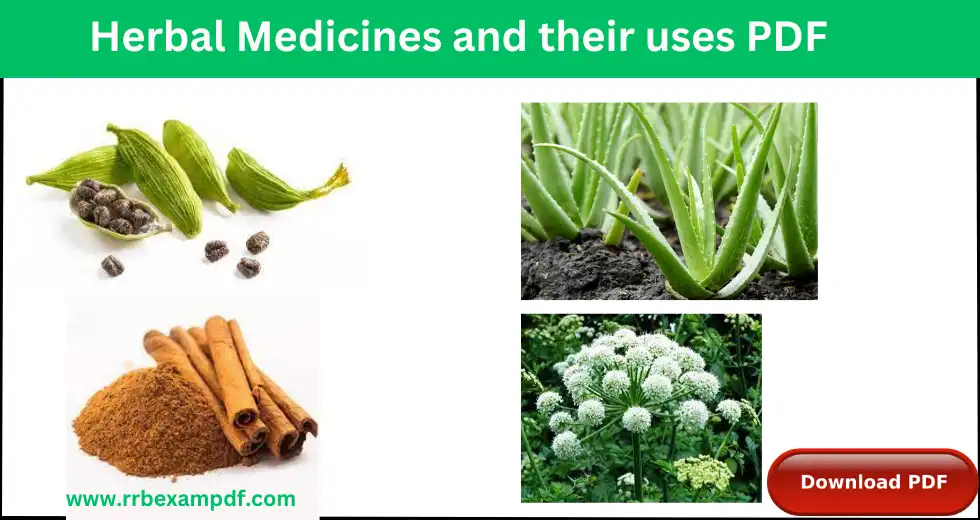List of Herbal Medicines and their uses PDF: medicinal plants and their uses pdf free download, 100 medicinal plants and their uses with pictures pdf download, old herbal medicine books pdf, herbal medicine pdf 2020, african herbal medicine books pdf, list of african herbal medicines and their uses pdf, handbook of 200 medicinal plants pdf.
In a world that’s increasingly embracing natural and holistic approaches to health, herbal medicines have emerged as a powerful and time-tested alternative to conventional pharmaceuticals. The remarkable healing properties of herbs have been harnessed for centuries, offering a range of benefits to address various health concerns.

Top List of Herbal Medicines and their Uses PDF
1. Turmeric (Curcuma longa)
Turmeric, a vibrant yellow spice commonly found in many kitchens, holds a treasure trove of healing potential. Its active compound, curcumin, possesses potent anti-inflammatory properties, making it a valuable aid for managing conditions such as arthritis and digestive disorders.
2. Peppermint (Mentha piperita)
Peppermint, with its invigorating aroma and cooling sensation, is known for its ability to soothe digestive discomforts and alleviate headaches. Its essential oil is often used in aromatherapy to promote mental clarity and ease tension.
3. Lavender (Lavandula angustifolia)
Lavender’s delicate purple blooms emit a calming scent that’s celebrated for its relaxation-inducing effects. Lavender essential oil can be used to promote better sleep, reduce anxiety, and alleviate skin irritations.
4. Echinacea (Echinacea purpurea)
Echinacea is a popular herb used to support the immune system. It’s believed to stimulate immune responses, making it a go-to remedy for warding off colds and flu.
5. Ginger (Zingiber officinale)
Ginger is not only a culinary delight but also a versatile herbal remedy. Its anti-nausea properties are particularly well-known, making it a trusted ally for combating motion sickness and morning sickness.
6. Ginseng (Panax ginseng)
Ginseng is considered an adaptogen, which means it helps the body adapt to stress and restore balance. It’s known to boost energy, enhance cognitive function, and support the immune system.
7. Chamomile (Matricaria chamomilla)
Chamomile’s gentle nature makes it a beloved herb for calming frayed nerves. Its tea is often used to promote relaxation and ease digestive discomfort.
8. St. John’s Wort (Hypericum perforatum)
St. John’s Wort is renowned for its mood-balancing properties. It’s commonly used to manage mild to moderate depression and ease symptoms of anxiety.
9. Aloe Vera (Aloe barbadensis)
Aloe vera’s gel, extracted from its succulent leaves, is prized for its soothing effect on skin irritations, burns, and minor wounds. It’s also used internally to support digestive health.
10. Valerian (Valeriana officinalis)
Valerian is a potent herbal sedative used to promote relaxation and improve sleep quality. It’s often employed as a natural remedy for insomnia.
100 medicinal plants and their uses with pictures pdf download
- Arnica: Applied topically to alleviate muscle pain, bruises, and inflammation.
- Ashwagandha: An adaptogenic herb used to support stress management and promote overall well-being.
- Astragalus: Known for its potential immune-boosting properties and used to support overall health.
- Basil: Used for its aromatic properties and in traditional medicine for its potential digestive and anti-inflammatory benefits.
- Black Cohosh: Traditionally used to alleviate symptoms of menopause, such as hot flashes and mood swings.
- Calendula: Applied topically for its soothing and healing effects on the skin.
- Cat’s Claw: Known for its potential immune-stimulating and anti-inflammatory properties.
- Cayenne Pepper: Used to improve circulation and as a natural pain reliever.
- Chamomile: Often consumed as a tea to promote relaxation, relieve stress, and aid in sleep.
- Chaste Tree: Traditionally used to regulate menstrual cycles and alleviate symptoms of premenstrual syndrome (PMS).
- Cinnamon: Known for its potential antioxidant and anti-inflammatory properties.
- Cranberry: Used to support urinary tract health and prevent urinary tract infections.
- Dandelion: Known for its potential diuretic properties and used to support liver and kidney health.
- Dong Quai: Traditionally used to support female reproductive health and alleviate menstrual symptoms.
- Echinacea: Used to support the immune system and help prevent or treat colds and flu.
- Elderberry: Known for its potential antiviral properties and used to support immune health.
- Eucalyptus: Used for its potential respiratory benefits and as a topical treatment for muscle soreness.
- Evening Primrose: Known for its potential hormonal balancing effects and used to alleviate symptoms of PMS and menopause.
- Fenugreek: Traditionally used to support digestive health, lactation, and blood sugar control.
- Feverfew: Used to alleviate headaches and migraines, and for its potential anti-inflammatory properties.
- Garlic: Known for its potential cardiovascular benefits and immune-boosting properties.
- Ginger: Used as a digestive aid and for relief from nausea, indigestion, and motion sickness.
- Ginkgo Biloba: Traditionally used to support cognitive function and improve memory.
- Ginseng: Known for its potential energy-boosting properties and as an adaptogen to help manage stress.
- Goldenseal: Traditionally used as a natural antibiotic and for its potential immune-stimulating properties.
- Gotu Kola: Used to support cognitive function and improve circulation.
- Grape Seed Extract: Known for its potential antioxidant properties and used to support cardiovascular health.
- Green Tea: Rich in antioxidants and used for its potential metabolism-boosting effects.
- Hawthorn: Known for its potential cardiovascular benefits, often used to support heart health.
- Holy Basil: Used for its potential stress-relieving properties and as an adaptogen.
- Horse Chestnut: Traditionally used to alleviate symptoms of varicose veins and improve circulation.
- Lavender: Known for its calming and soothing effects, often used for relaxation and stress relief.
- Lemon Balm: Used for its potential calming effects and to support relaxation and sleep.
- Licorice Root: Used for its potential anti-inflammatory properties and as a soothing herb for digestive issues.
- Milk Thistle: Used to support liver health and aid in detoxification.
- Mullein: Traditionally used to alleviate respiratory conditions, such as coughs and congestion.
- Nettle: Known for its potential anti-inflammatory properties and used to support allergies and urinary tract health.
- Oregano: Used for its potential antimicrobial and antioxidant properties.
- Passionflower: Known for its potential calming effects and used to support relaxation and sleep.
- Peppermint: Used to soothe digestive discomfort, such as indigestion, bloating, and IBS symptoms.
- Red Clover: Traditionally used to support hormonal balance and alleviate menopausal symptoms.
- Reishi Mushroom: Known for its potential immune-modulating properties and used to support overall health.
- Rhodiola Rosea: An adaptogenic herb used to support energy, endurance, and stress management.
- Rosehip: Rich in antioxidants and used to support immune health and joint function.
- Sage: Traditionally used to support cognitive function and alleviate menopausal symptoms.
- Saw Palmetto: Often used to support prostate health and relieve symptoms of BPH.
- Schisandra: Known for its potential adaptogenic and liver-protective properties.
- Slippery Elm: Used to soothe and protect the digestive tract, often used for relief from heartburn and GERD.
- St. John’s Wort: Often used as a natural remedy for mild to moderate depression and mood disorders.
- Turmeric: Contains curcumin, known for its anti-inflammatory properties, often used to support joint health and reduce inflammation.
- Uva Ursi: Traditionally used to support urinary tract health and alleviate urinary tract infections.
- Valerian: Used as a sleep aid and to reduce anxiety, promoting relaxation and improving sleep quality.
- White Willow Bark: Traditionally used for its potential pain-relieving and anti-inflammatory properties.
- Witch Hazel: Applied topically for its astringent and soothing effects on the skin.
- Yarrow: Known for its potential anti-inflammatory and wound-healing properties.
- Yellow Dock: Used to support liver health and aid in detoxification.
- Yohimbe: Traditionally used for its potential aphrodisiac properties, although caution is advised due to potential side effects.
- Acai Berry: Known for its potential antioxidant properties and used to support overall health.
- Alfalfa: Rich in nutrients and used to support digestion, joint health, and overall well-being.
- Andrographis: Known for its potential immune-boosting and anti-inflammatory properties.
Details of List of Herbal Medicines and their uses PDF
| PDF Name | List of Herbal Medicines and their uses PDF |
| No. of Pages | 181 |
| PDF Size | 8.20 mb |
| Language | English |
| PDF Category | Health & Fitness |
| Download Link | Available |
| Published/Updated | 30th June 2023 |
| Source / Credits | who |
This list provides a wide range of herbal medicines and their traditional uses, but it’s important to note that the effectiveness and safety of these herbs may vary. Always consult with a qualified healthcare professional or herbalist before using herbal remedies, especially if you have any underlying health conditions or are taking medications. They can provide personalized guidance based on your specific needs and circumstances.
Download the pdf of List of Herbal Medicines and their uses PDF
To download the pdf of List of Herbal Medicines and their uses, you can download the pdf download the pdf from below link-
Disclaimer: We have neither copied nor scanned this book, we are only sharing the links already available on the internet for the purpose of education. If any person/organization has any objection related to these notes/books, please contact us, and we will remove these links as soon as possible. Email – rrbexampdf@gmail.com
- Also Read-
- Neelima Malik Oral Surgery Pdf



